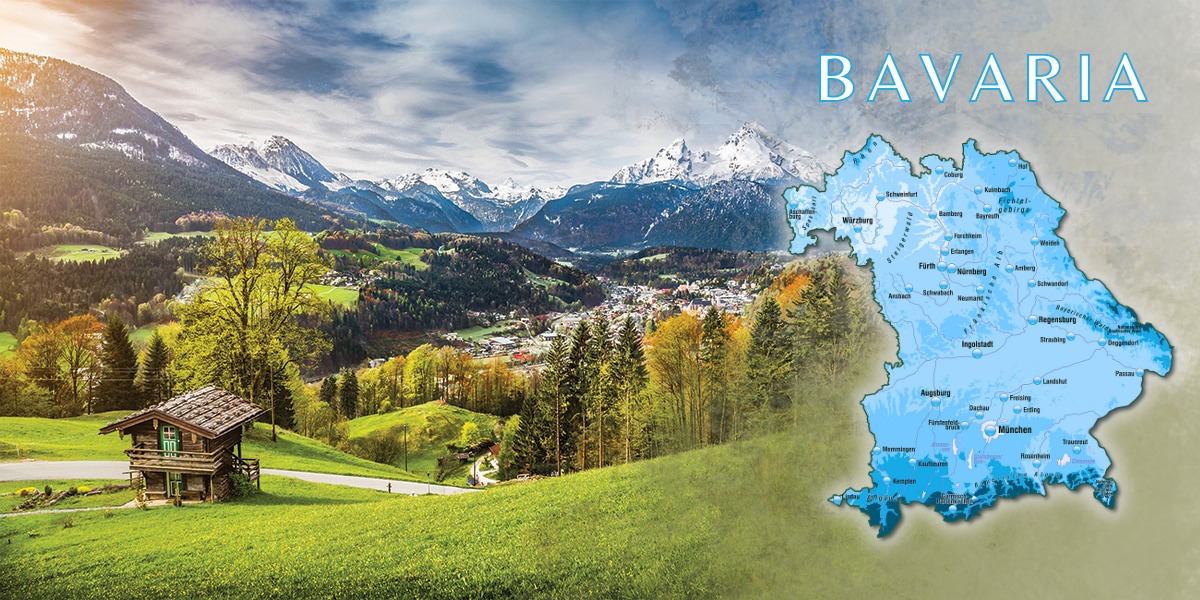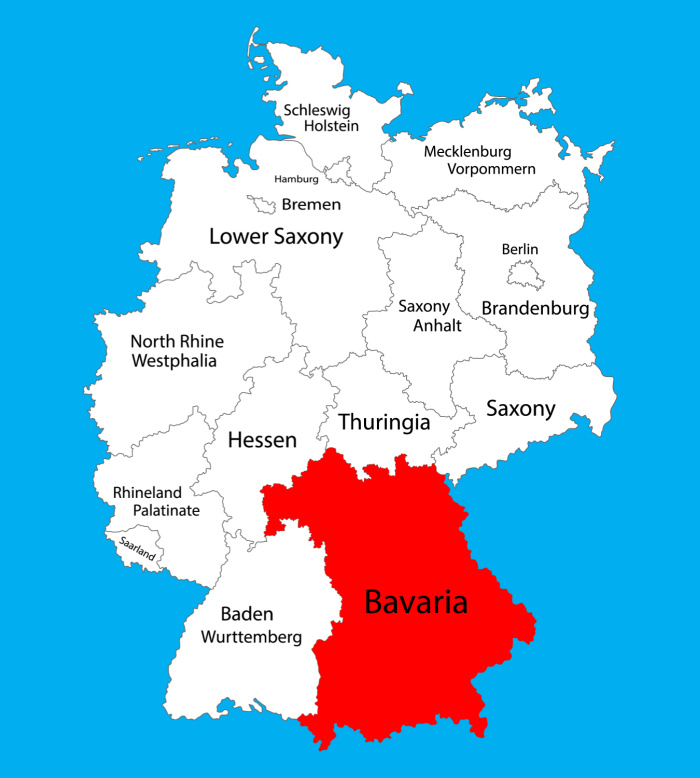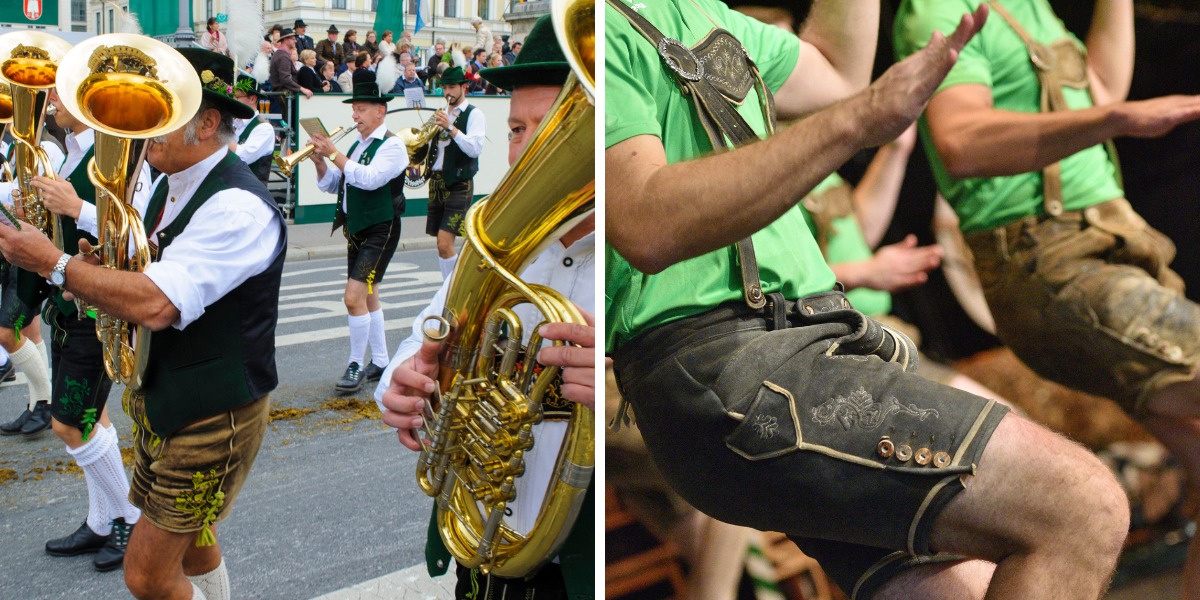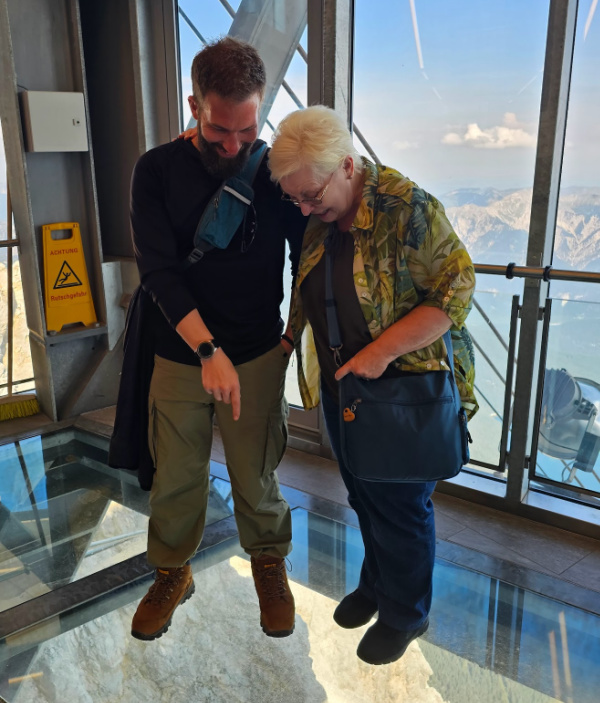- Home
- 16 Federal States of Germany
- Discover Bavaria
Discover Bavaria: Your Best Travel Guide to Bayern
By: Gerhild Fulson / Using her extensive experience and cultural knowledge, Oma Gerhild provides trusted, authentic, and easy-to-follow German recipes both here and in her many cookbooks.
Guten Tag! Get ready to discover Bavaria (German: Bayern), a place that’s a perfect blend of stunning landscapes, rich history, and vibrant culture. Located in southern Germany, the Free State of Bavaria is known for its old-world traditions, mouth-watering local dishes, fairy-tale castles, and much more.

Join me as we unpack what makes this region truly unique and worthy of a visit — a place where modern life and deep-rooted customs go hand-in-hand. Sit back, grab a pretzel, and let's tour into the heartlands of Bavaria together. It's time to discover Bavaria!
On this page:
A bit of Bavarian history
We'll start our journey to discover Bavaria with a bit of history and a geography lesson. Bavaria wasn't always the lederhosen-and-dirndl-wearing, laid-back place that we know and love today. Its story begins way back around the 6th century (yes, it's older than some countries!).
The region was first inhabited by several Germanic tribes before it became a duchy under the dominion of the Holy Roman Empire in the 6th century. The Middle Ages were a tumultuous time for Bavaria, fluctuating between expansion and territorial loss due to recurring skirmishes and political developments.
In 1180, Otto I Wittelsbach became Bavaria's Duke, establishing the Wittelsbach Dynasty that would control Bavaria for over 700 years. His descendants turned Bavaria into a center of culture, the arts, and sciences. The Wittelsbach rule saw a number of architectural triumphs, including King Ludwig's Neuschwanstein Castle.
Heading towards modern history, the Treaty of Pressburg in 1805 marked a major change for the state, as it was elevated to the status of a kingdom. During the Napoleonic era, this elevated status was further strengthened, granting it further territorial entitlements.
Bavaria joined the German Empire in 1871 but remained self-governed. The first half of the 20th century was a challenging period for Bavaria. It was marked by:
- The downfall of the monarchy at the end of World War I
- The brief existence of the Bavarian Soviet Republic in 1919
- The rise of National Socialism in the 1920s and 30s, with Munich becoming a crucial epicenter for Hitler's propaganda.
Post World War II, the American military government established Bavaria as a state in 1946. Today, Bavaria is one of Germany's most prosperous states, offering an exceptional quality of life, a robust economy, and yet, holding on to its historic heritage and cultural uniqueness.
The beauty of Bavaria lies in the harmonious contrast of its prominent past and vibrant present, a testament to its resilience. Its diverse history offers an enriching backdrop to its picturesque landscapes, making every moment spent here all the more meaningful.
Where in the world is Bavaria?
Situated in the southeastern corner of Germany, Bavaria is the largest state in the Germany, spanning over 27,250 square miles (70,550 square kilometers). It shares its borders with Austria to the east and south, the Czech Republic to the east, and Switzerland to the southwest.

Bavaria's topography is an interesting blend of lowlands, highlands, and mountains. The northwest part of Bavaria is marked by the Franconian Heights, giving way to fertile plains and architecturally rich cities such as Nuremberg. Further south and east, the topography changes dramatically to the Bavarian Forest, the state's oldest national park.
The most dominating landscape is the Bavarian Alps. This mountain range, with the Zugspitze as its highest peak at almost 10,000 feet (2,962 meters), spans the state's southern region and forms a natural border with Austria. This alpine region is a treasure trove for nature lovers, hikers, and winter sports enthusiasts.
Adding to Bavaria's geographic charm are the numerous lakes and rivers. The state's serene lakes, the Chiemsee, Königssee, and Starnberger See, serve as popular getaway spots. The Danube River begins in the Black Forest, while the Isar River winds through Munich (apparently the Monks liked the taste of the water and settled here ... hence Munich).
The climate, though, is a mixed bag, with moderate to heavy snowfalls in winter, especially in the Alpine region, making it a perfect place for winter sports, and pleasantly warm and mostly mild (but surprisingly not too hot) summers.
Bavaria, with its diverse topography and climate, is an ideal destination for tourists to visit and stay a while.
Discover the Unique Culture of Bavaria
Touring Bavaria feels like stepping into a beautifully preserved cultural time capsule. Bavarians have a unique sense of pride and preservation when it comes to their customs and traditions.
Bavarian Dialect
The Bavarian dialect is the first thing that stands out. Spoken predominantly in the rural areas of Bavaria, each region has subtle differences in the dialect. Even if you're fluent in German, the Bavarian dialect can come as a surprise due to its unique intonations and vocabulary. But don't worry, almost everyone speaks Hochdeutsch ('high' German) as well.
Bavarian Tracht
Bavarians take great pride in their traditional clothes, or Tracht. Lederhosen, knee-length leather breeches for men, and Dirndl, a peasant-style dress for women, are popular. While commonly worn during major festivals, you can often spot locals wearing them in everyday life, symbolizing their strong sense of cultural identity.
Bavarian Festivals
Festivals play a central role in Bavarian culture. Oktoberfest is arguably the best-known celebration, attracting millions of tourists to Munich for 16 days of food, beer, and merriment. However, many other seasonal festivals, such as Fasching (known as Karnival elsewhere), Maibaumfest (celebrating the start of spring), and the Christkindlmarkts (Christmas markets) in December, are all intrinsically Bavarian.
Bavarian Music/Dance
The fondness for traditional music and dance can't be overlooked. Brass bands, locally known as Blaskapelle, frequently play at local festivals.
Two of the most popular traditional folk dances are the Schuhplattler ('shoe slapping') with its rhythmic jumping, clapping, slapping, and stomping, and the Zwiefacher ('double' or 'twice') characterized by its irregular rhythms, combining several different steps in hundreds of different patterns in order to match the music.
Perhaps arrange for some dance lessons during your trip? It might well be the most unique way to discover Bavaria.
 Keep those knees up!
Keep those knees up!Bavarian Cuisine
At the very start of this article, I mentioned mouth-watering local dishes. Bavarian cuisine is a paradise for foodies. From Weißwurst (a traditional white sausage) to Brezn (Pretzels or Brezel in High German) and the variety of beers, Bavaria has it all. Look through my German Food Guide to find traditional Bavarian food, most including recipes, so you can make them once you're back home.
Bavarians are also known for their ‘Gemütlichkeit,’ a feeling of warmth, friendliness, and good cheer. Local beer gardens and taverns perfectly capture this sense of Gemütlichkeit with their communal tables and live traditional music.
All told, Bavarian culture is a harmonious blend of customs that have been honored for centuries and infused with contemporary influences.
The Best Places to Discover Bavaria
Bavaria's sheer size indicates how many surprises it has in store for tourists; let's take a peek at some of these!
Munich
Starting off with the crown jewel, Munich (München), Bavaria's capital. Its blend of cosmopolitan life with a hearty dose of traditional Bavarian charm is unmatched. Make sure to visit the historic new and old town halls in the Marienplatz, with the iconic Glockenspiel and the largest city palace in Germany, the Munich Residenz, the former royal palace of the Wittelsbach monarchs.
Explore the Englischer Garten (English Garden), one of the world's largest urban parks, and if you're into art, the Pinakotheken Museums are an absolute must-visit. For football fans, the Allianz Arena, home to FC Bayern Munich, should be on your list, and then browse through our guide to Munich: Things To Do And The Best Attractions To See. You're sure to find more to add to your to-see-and-do list.
 Munich Residenz, Englischer Garten, and the New Town Hall.
Munich Residenz, Englischer Garten, and the New Town Hall.Nuremberg
Next up is Nuremberg (Nürnberg). Nuremberg Castle, the Albrecht Durer House, and the Nuremberg Christmas Market all make Nuremberg worth visiting. Don't forget to stop by the Bratwurst Röslein that's located right beside the Christmas Market.
 Eran waiting for our group to arrive to enjoy a traditional Nürnberger Bratwürste feast at the Bratwurst Röslein.
Eran waiting for our group to arrive to enjoy a traditional Nürnberger Bratwürste feast at the Bratwurst Röslein.Claimed to be the largest Bratwurst restaurant in the world, it has its origins way, way back to 1480, when there was a mention of an eatery called "Zu den drei Rosen". And who was one of the Stammgäste (frequent visitors)? The well-known Albrecht Dürer (1471–1528).
Oh, another foodie place not to miss is the world-famous Hofbräuhaus, even if just for a taste of traditional Bavarian beer.
Füssen
Neuschwanstein Castle should be next on your bucket list. Nestled near Füssen with an awe-inspiring backdrop of the Alps, the fairytale castle is a window into the royal lifestyle and fantasy world of King Ludwig II of Bavaria. It's a must-visit, as are these five romantic castles (which include Nymphenburg Palace).
Oh, while you are near Füssen, you really need to take the cable car up Germany's highest peak, the Zugspitze (also called Germany's Rooftop). Then, hand your camera/phone to someone and get a photo of yourself standing on the glass floor ... looking down, ... way down, just like we did.
 Eran & I are standing on glass floor at the top of the Zugspitze! That took me a bit of persuasion, for sure!
Eran & I are standing on glass floor at the top of the Zugspitze! That took me a bit of persuasion, for sure!Regensburg
Regensburg, an often overlooked city, is a UNESCO World Heritage site with historical gems like the Steinerne Brücke (Stone Bridge) and the Dom St. Peter (Cathedral of St. Peter). The Old Town is full of medieval charm, waiting to be discovered.
Oh, then there's the historic town of Amberg ... Oh, I could go on and on ...
Romantic Road
Germany's Romantic Road is a scenic road trip that passes through picturesque and medieval towns with half-timbered houses. Don't miss the stops at enchanting Rothenburg ob der Tauber and the medieval city of Augsburg. All along the way, you'll see signs for the Romantische Straße. Follow them for an unforgettable way to discover Bavaria.

If you are a nature lover, then head southeast to charming Berchtesgaden and lose yourself in the beauty of its National Park and Königsee, Germany's deepest and cleanest lake.
So lace up your hiking boots, grab a bike, rent a car, or hop on a train! Bavaria's mix of iconic landmarks, beautiful towns, and hidden gems beckon you to dive in and discover more.
Additional Travel Tips
Are you ready to pack your bags for your Bavarian adventure? But wait! Here are some useful tips that will help make your journey smoother.
When to come
First, consider which season would be the best time for your visit. Bavaria showcases its beauty year-round, but each season has its own unique charm. December's Christmas markets transform cities into fairy-tale winter wonderlands, but it's quite chilly. The summer months from June to August tend to be warm and are great for outdoor activities and beer garden visits, while the cooler autumn weather calls for Oktoberfest!
 It's always a good time, whatever the season.
It's always a good time, whatever the season.How to travel
Transportation in Bavaria is incredibly efficient. Train travel connects cities and towns with ease. Tourists looking to venture off the beaten track might decide that the best way is to rent a car for more freedom. Known for the famous autobahn without speed limits, you should be aware though, that there are many places where speed limits are very strictly enforced.
For inner-city travel, public transportation like the U-Bahn (underground subway), S-Bahn (urban-suburban rail), trams, and buses are all reliable options. And yes, they are punctual. Several cities have city cards like Munich's CityTourCard or the Nuremberg Card that offer unlimited public transportation and discounts at various attractions. These can be real money-savers.
Local customs
Familiarize yourself with some local customs. Bavarians are generally friendly and direct. With their love for preserving tradition, cultural etiquette is appreciated. For instance, when toasting, it's important to maintain eye contact when clinking those glasses. Prost!
Speak like a local?
Although many Bavarians are pretty fluent in English, learning some of the most commonly used phrases makes travel so much more fun. Here are some to get you started:
Bavarian > High German > English:
- Seavus (Servus) > Hallo > both Hello and Goodbye
- Grias god (Grüß Gott) > Hallo > formal Hello (greet God)
- Grias di (Grüß dich) > Hallo > informal Hello (greet you)
- Pfiat di (in a nice tone) > Tschüss > Goodbye
Note: Pfiat di in a nasty tone means "get lost!"
- Via ged's eana? > Wie geht’s Ihnen? > formal "How are you?"
- Via ged's? > Wie geht’s? > How are you?
- Šena dåg no > einen schönen Tag noch > have a nice day
- Duad ma laid > Es tut mir Leid > I’m sorry
- I vasteh des ned > Ich verstehe nicht > I don't understand
- Dang šee > Danke > thank you
- Vo is as glo? > Wo ist die Toilette? > Where is the restroom?
- Oiss guade zum buadsdåg > Alles Gute zum Geburtstag > Happy birthday!
With these words and travel tips under your belt, you're ready to embark on an unforgettable journey. All that's left is for you to immerse yourself in the wonders of Bavaria and create memories that will last a lifetime. Safe travels, or as the locals say, "Kim guad o" (> Komm gut an > Have a good trip).
And our journey comes to an end here, but your voyage of discovery is just beginning! Bavaria is a land of charming traditions, stunning landscapes, and friendly people. Plan now to take time to discover Bavaria, take in its historic splendor, enjoy its culinary delights, and create unforgettable memories.
Seavus und auf Wiedersehen ... until we meet again, in the heart of beautiful Bavaria!
